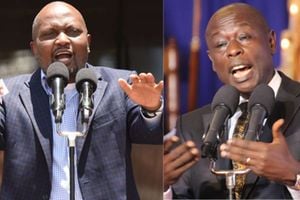We all have a duty to keep the great devolution promise alive

Deputy Chair Council of Governors James Ongwae (right) addresses the media at the COG's Secretariat on August 12, 2021. He flanked by Makueni Governor Kivutha Kibwana (centre) and the latter's deputy Ms Adelina Mwau.
What you need to know:
- Unknown to most Kenyans today, the “majimbo” system was more robust than the current devolved system.
- The regional governments had more power and resources and could veto national-government decisions that undermined regionalism.
One special gift Kenya’s 2010 Constitution bequeathed to the country was devolution, which guarantees decentralised power, resources, public decision-making, citizens’ participation and jobs.
Formerly marginalised areas are beginning to feel included in enterprise Kenya. Good examples are North and Upper Eastern Kenya, parts of North Rift, the Coast and Lower Eastern regions.
Kenya’s initial sub-national governments system was killed because the dominant leadership had opportunistically conceded to “majimbo” merely to please the white settlers and leaders of the minority tribes. By end of 1964, the quasi-federal system was predictably dismantled.
Unknown to most Kenyans today, the “majimbo” system was more robust than the current devolved system. The regional governments had more power and resources and could veto national-government decisions that undermined regionalism.
Had the system survived to the present, of course with necessary modifications, Kenya would be a middle-level economy.
To a large extent, the quasi-federalism favoured by the Bomas draft constitution was a near replica of the 1963 regional system. Regions were created above the district level of government (which became counties later).
Significant resources were expected to flow into the new tiers of government. When the Bomas draft was “mutilated” in Kilifi and Naivasha, devolution became one of the major casualties. There was a deliberate attempt to reduce county governments to the previous local governments supervised by the Ministry of Local Government.
What were the salient features of the Bomas-type devolution that were discarded?
Devolution conferences
First to be expunged were the regions. It was argued that they were founded on ethnicity and hence would exacerbate division. However, the 47 counties were essentially one-dominant-ethnic-group entities.
The taxation power of the counties resembles that of the former local authorities. Article 209(3) provides that a county may impose property rates, entertainment taxes; and any other taxes determined by national legislation including charges for services. Counties are left to levy minor fees for business licences, cess, parking fees and so on.
The bulk of the country’s taxes are collected by the national government, and through the National Treasury and Parliament, the counties often do not receive the minimum 15 per cent of revenue.
In 2013, the Transition Authority did not conduct sufficient capacity building for the incoming county leadership and staff. Governors and county staff were thrown into the deep sea and expected to swim.
As resolutions from the six devolution conferences show, the costing of the fourth-schedule national and county government functions has never been done. As a result, it is impossible to determine the resources that should follow functions. With the national government keeping resources for county functions such as health and agriculture, some county functions remain un(der)performed for lack of funds.
Meagre resources also mean counties hardly undertake major development programmes. Most deploy their resources on staff pay, other recurrent expenditure and “subsistence development”.
The fifth schedule of the 2010 Constitution detailed all the laws that were to be enacted by Parliament to ensure the national government could appropriately execute its functions.
Dire consequences
Strict timelines were provided within which the laws would be passed, with dire consequences in case of default. This was not done for devolved units.
The counties were left to improvise on how to develop policies, laws, systems, processes and procedures. No wonder a basic common framework does not exist to guide counties in these areas.
Even when Parliament passes legislation concerning county governments, such laws tend to undermine their functions. Between 2013 and 2017, the Council of Governors and the national government were locked in court battles.
What are other highlights from the deliberations of the six devolution conferences?
The Kwale 2014 conference focused on the teething problems that confronted devolution. It noted devolution had taken off reasonably well but needed support to thrive.
The Kisumu 2015 conference noted “the devolution promise” was a permanent national feature that needed continuous improvement. Other key requirements were a comprehensive framework for public participation and civic education, (a theme emphasised in all subsequent conferences); speedy transfer of all county functions; prompt disbursement of county funds; strengthening co-ordination between governors, senators and county assemblies; clear parliamentary support of devolution; schemes of service for all cadre of staff; implementing the two-third gender rule nationally and in counties; a county boundary dispute resolution mechanism; and, creating a culture of rule of law.
The Meru 2016 conference stressed on safeguarding of devolution gains; increasing equitable share progressively; expeditious disbursement of funds to counties; stopping state corporations from usurping county functions; and fighting corruption.
The Nakuru 2017 conference recommended raising the equitable share to 45 per cent; stopping state agencies and regional development authorities from usurping county functions; disbursement of grants directly to counties; and curbing double taxation at both levels of government.
Review the journey
The Kakamega 2018 conference focused on county governments contribution to the Big Four Agenda; affirmative action in top positions; unbundling of concurrent functions; local bench-marking and knowledge-sharing among counties; lifestyle audits to combat graft; addressing climate change; and Senate’s defence of devolution.
The 2019 Kirinyaga conference emphasized effective coordination between the two levels of government; creation of cottage and agro-processing industry to benefit marginalised populations; establishment of county service delivery units and regional economic blocs; reduction of cost of doing business in Kenya; involving research, academic and private sector institutions in governance; engendering performance management culture in counties; harmonising revenue collection between national and county levels; and, reviewing the law to ensure Parliament does not delay the approval of audited accounts.
The seventh Makueni 2021 devolution conference provides an opportunity to review Kenya’s devolution journey since inception and to audit the extent to which past resolutions have been implemented.
The conference will discuss the global climate crisis and the measures taken to address this phenomenon.
Evidently, devolution holds the key to the country’s transformation and prosperity despite its current challenges.
Unfortunately, the national government, the Senate and the National Assembly tend to view counties as little brothers or little sisters who must paternalistically be aided to accomplish their functions.
For devolution to triumph, this perception must change. The people must continue to defend it and county and national leaders need to commit to integrity and service.
Prof Kibwana is the Governor of Makueni County





